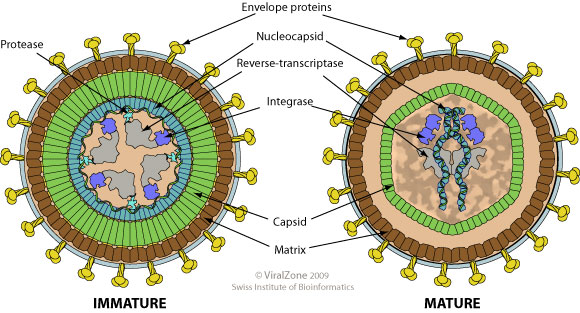Molecular biology
VIRION

Enveloped. Spherical to pleomorphic, about 80-100 nm in diameter.
GENOME

Monopartite, linear, dimeric, ssRNA(+) genome of 8,9 kb, with a 5'-cap and a 3'poly-A tail. There are two long terminal repeats (LTRs) of about 600nt long at the 5' and 3' ends. The LTRs contain the U3, R, and U5 regions. There are also a primer binding site (PBS) at the 5'end and a polypurine tract (PPT) at the 3'end.
GENE EXPRESSION
The integrated provirus utilizes the promotor elements in the 5'LTR to drive transcription. This gives rise to the unspliced full length mRNA that will serve as genomic RNA to be packaged into virions or used as a template for translation of gag, gag-pro (1 ribosomal frameshift), and gag-pro-pol (2 ribosomal frameshifts) polyproteins. The singly spliced mRNA encodes env that is cleaved into SU and TM envelope proteins. Completely spliced mRNAs encode Rex and Tax. Rex escorts unspliced and singly spliced RNAs out of the nucleus of infected cells. Tax is a transcriptional activator that activates viral and cellular genes.
REPLICATION
NUCLEAR
Lytic replication:
- Virus attaches to host receptors through the SU glycoprotein. TM glycoprotein mediates fusion with cell membrane.
- Internalization and uncoating.
- ssRNA(+) genome is copied into a linear dsDNA molecule by the reverse transcriptase.
- Nuclear entry of the viral dsDNA which is covalently and randomly integrated into the cell's genome by the integrase (=provirus).
- Transcription of provirus by Pol II produces viral spliced and unspliced RNAs.
- Translation of spliced viral RNAs produces tax and rex proteins.
- Rex mediates nuclear export of the uncompletely spliced RNAs.
- Translation of unspliced viral RNAs produces Env, Gag, Gag-Pro and Gag-Pro-Pol polyproteins.
- Assembly of the virion at the host cellular membrane and packaging of the viral RNA genome.
- Budding through the plasma membrane and release of the virions.
- Proteolytic processing of the precursors polyproteins by viral protease and maturation of the virions.
Latent replication : replication as a provirus integrated in the host chromosome.

